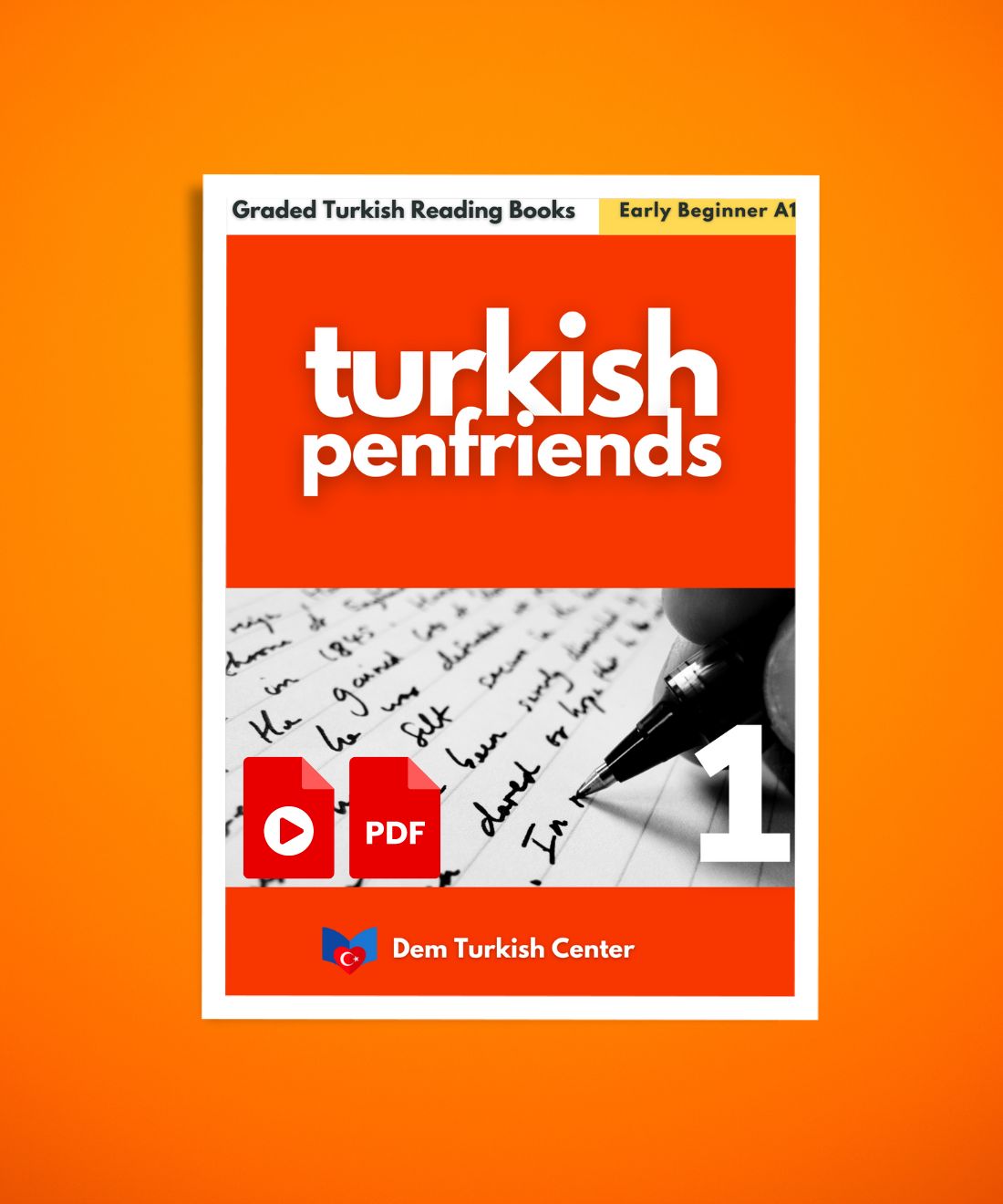
How to speak Turkish fluently
To learn Turkish fluently, you’ll need a well-rounded approach that goes beyond basic language learning and incorporates advanced listening, speaking, reading, and writing practices.
Become a DTC member and get the full access to the bookstore!
Fluency means being able to understand and respond in real-life conversations, grasp idiomatic expressions, and convey complex thoughts accurately. Here's a detailed roadmap to help you achieve fluency in Turkish:
1. Set Clear Goals and Objectives
Define Fluency
What does fluency mean to you? Is it being conversationally fluent, academically fluent, or professionally fluent in Turkish? Tailor your learning plan based on your objectives.
Time Commitment
Fluency requires consistent practice over months or even years. Aim for at least 1–2 hours a day dedicated to Turkish learning.
2. Master the Turkish Alphabet and Pronunciation
Perfect Pronunciation
Revisit the Turkish alphabet and pronunciation rules. Fluent speakers must have clear and accurate pronunciation. Pay close attention to the following letters: "ğ", "ı", "ö", "ü", which are unique to Turkish.
Phonetic Drills
Use phonetic exercises and tongue twisters in Turkish to refine your accent.
3. Expand Turkish Vocabulary Beyond Basics
Themed Vocabulary
Focus on advanced themes such as politics, economics, history, culture, and science. You can create categories like "environment", "technology", "current events", etc.
Use Vocabulary Notebooks
Maintain a physical or digital notebook of new words. Practice by creating sentences using each new word in context.
Active Use of Synonyms and Antonyms
Learn synonyms and antonyms to expand your ability to express the same idea in different ways.
4. Develop Complex Grammar Understanding
Fluency requires a deep understanding of grammar, especially the following areas:
Advanced Tenses in Turkish
Learn how to express hypothetical situations (with the subjunctive and conditional forms).
Master the nuances of Turkish tenses (e.g., simple past, reported past, future perfect, etc.). For example:
Geleceğini sanmıyorum. I don’t think he/she will come.
Learn the basic Turkish verb tenses!
Complex Sentence Structures
Practice combining clauses with conjunctions like çünkü (because), ama (but), eğer (if), ki (that).
Master relative clauses (using the suffixes "-en", "-an") to express more intricate thoughts. For example:
Kitabı okuyan çocuk gitti. The child who read the book left.
Download Turkish grammar worksheets (PDF worksheets + video lessons) for self-study!
Use of Suffixes in Turkish
Turkish is a suffix-heavy language.
Practice: Adding possessive suffixes (e.g., "-im", "-in", "-i").
Verb forms (e.g., participles, gerunds) that add layers of meaning and fluidity to speech.
5. Immerse Yourself in Turkish Media
Immersion is one of the best methods to gain fluency. Here’s how you can immerse yourself effectively:
Watch Turkish TV Series/Films
Turkish dramas are known for their rich dialogue. Try watching without subtitles to enhance your listening comprehension.
Follow Turkish News
Watch Turkish news channels such as NTV or CNN Türk. This will expose you to formal and professional Turkish used in daily news reports.
YouTube Channels
Subscribe to Turkish YouTubers or vloggers who talk about subjects you enjoy (travel, science, culture, etc.).
Follow "Turkey1001" youtube channel!
6. Engage in Conversations
To be fluent, you need constant practice in real-life conversations. Here's how:
Language Exchange Partners
Use platforms like Tandem, HelloTalk, or Speaky to find Turkish-speaking partners. Regularly engage in voice or video calls.
Hire a Turkish Tutor
Consider hiring a Turkish tutor.They can help correct your mistakes in real-time and introduce advanced speaking techniques.
Imrprove your Turkish with Turkish classes online!
Join Turkish Language Meetups
Look for Turkish language groups or cultural clubs in your area or online. These groups often hold speaking sessions or events.
7. Advanced Reading Skills
Reading plays a crucial role in reaching fluency, especially when it comes to understanding cultural nuances, idioms, and complex sentence structures.
Download Turkish Reading Practice Course 1 A1!
Download Turkish Reading Practice Course 2 A2!
Download Turkish Reading Practice Course 3 PI!
Download Turkish Reading Practice Course 4 B1!
Newspapers and Articles
Start reading Turkish newspapers like Hürriyet*, Sabah, or Milliyet. Focus on different sections: politics, entertainment, business, etc.
Download Strange News 1 A1, a Turkish easy reading book with exercises!
Download Strange News 2 PI, a Turkish easy reading book with exercises!
Turkish Literature
Begin reading Turkish novels by famous authors such as Orhan Pamuk, Elif Şafak, or Yaşar Kemal. Their works will introduce you to a higher level of language.
Download Turkish Short Stories 1 PI, a Turkish easy reading book with exercises!
Download Turkish Short Stories 2 B1, a Turkish easy reading book with exercises!
Reading Blogs and Forums
Browse Turkish forums like Ekşi Sözlük to see how people write in informal or colloquial Turkish.
8. Advanced Writing Practice
Fluency also involves the ability to express complex ideas in writing:
Essay Writing
Start writing essays or opinion pieces on various topics. Use advanced grammar, transition words, and sophisticated vocabulary.
Daily Journals
Write about your daily activities in Turkish, but this time with a focus on sentence complexity and expression of abstract ideas.
Language Correction Platforms
Use apps like Lang-8 or HiNative where native speakers can correct your written Turkish.
9. Cultural Competence
Language and culture go hand in hand. To truly understand Turkish and use it fluently:
Study Turkish Culture and History
Read about Turkish history, traditions, and current events to grasp the cultural context of phrases and idioms.
Idioms and Proverbs
Fluency requires you to understand and use idiomatic expressions, which are common in Turkish conversation. For example:
Ateş almaya gelmek. Literally: "To come to take fire", meaning: "To visit briefly").
75 Funny Turkish Idioms and Sayings
10. Consistent Practice and Patience
Fluency is achieved through consistent and patient practice over time. Here’s how to maintain momentum:
Set Milestones
Create specific, measurable goals for yourself (e.g., "Hold a 10-minute conversation without pausing").
Track Progress
Use apps like Duolingo to keep track of your learning streaks and overall progress.
Review and Self-Correct
Constantly review areas where you feel weak (e.g., tenses, vocabulary) and practice to improve those areas.
Stay Motivated
Engage with Turkish culture through music, movies, food, and history to keep yourself motivated.
By following this roadmap with dedication and consistent practice, you will be well on your way to achieving fluency in Turkish!
Become a DTC member, get hefull access to the bookstore + online help / support - for 1 year!
Thank you very for your interest and visiting Dem turkish Center bookstore













